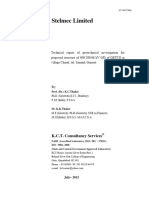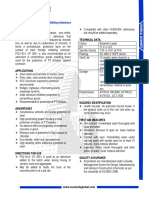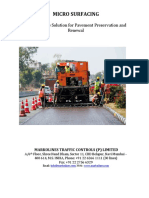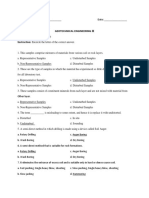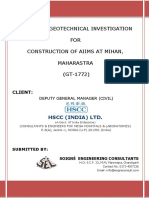Bharuch Bhadbhut Project SBC Report
Bharuch Bhadbhut Project SBC Report
Uploaded by
Aditya BhattCopyright:
Available Formats
Bharuch Bhadbhut Project SBC Report
Bharuch Bhadbhut Project SBC Report
Uploaded by
Aditya BhattOriginal Description:
Copyright
Available Formats
Share this document
Did you find this document useful?
Is this content inappropriate?
Copyright:
Available Formats
Bharuch Bhadbhut Project SBC Report
Bharuch Bhadbhut Project SBC Report
Uploaded by
Aditya BhattCopyright:
Available Formats
SOIL INVESTIGATION REPORT
for
Proposed Office Building at Bharuch for Bhadbhut Project Circle
of
Bhadbhut Project Division No.1, Bharuch
GEOTECHNICAL ENGINEERING LABORATORY
Department of Civil Engineering
S V National Institute of Technology,
SURAT – 395 007(Gujarat)
Feb – 2021
Geotechnical Engineering Laboratory, Civil Engineering Department, SVNIT, Surat Page 1
SOIL INVESTIGATION
for
Proposed Office Building at Bharuch for Bhadbhut Project Circle
1. INTRODUCTION
Safe Bearing Capacity report including soil investigation and laboratory testing for the
construction of proposed Office Building at Bharuch for Bhadbhut Project Circle was
referred to Civil Engineering Department, S V National Institute of Technology, Surat by
Executive Engineer, Bhadbhut Project Division No.1, Bharuch by letter No. Civil/BPDn-
1/PB/SBC Testing/Quotation/341 dated 23/12/2020. These were carried out as follows:
2. FIELD WORK
Drilling four bore holes of 150 mm diameter and up to maximum depth of 10.0 m
from the ground level.
Carried out standard penetration test (SPT) at every 3.0 m interval alternate to
undisturbed sampling.
Collecting undisturbed sample (UDS) at every 3.0 m interval alternate to SPT
Collecting disturbed sample (DS) at every 1.5 m interval.
Carried out three dynamic cone penetration test (DCPT) as per I.S. 4968 (Part-1)-
1976 (Reaffirmed 2002).
Observation of ground water table using drilled holes.
3. LABORATERY TESTING
Following laboratory tests were carried out to determine the physical and engineering
properties of disturbed and undisturbed soil samples. The test results are incorporated
along with bore log exploration datasheets.
Field density , Moisture content and Dry density of undisturbed sample
Confirming to IS 2720 Part 9 -1992 (Reaffirmed 2002)
Grain size analysis
Confirming to IS 2720 Part 4 -1985 (Reaffirmed 2006)
Geotechnical Engineering Laboratory, Civil Engineering Department, SVNIT, Surat Page 2
Atterberg limits
Confirming to IS 2720 Part 5 – 1985 (Reaffirmed 2006)
Specific gravity test
Confirming to IS 2720 Part 3 – Section 2 – 1980 (Reaffirmed 2002)
Free swell test
Confirming to IS 2720: Part 40 -1977 (Reaffirmed 2002)
Shear test
Confirming to IS 2720 Part 13 1986 (Reaffirmed 2002)
Standard penetration test
Confirming to IS 2131 - 1981 (Reaffirmed 2002)
4. STANDARD PENETRATION TEST
A standard hammer of 63.5 kg is dropped from a height of 75 cm and the number of
blows for penetration of split spoon sampler for 0-15, 15-30 and 30-45 cm are
recorded. SPT (Nf) value is considered for 15-45 cm penetration value.
5. DISTURBED AND UNDISTURBED SAMPLE
Disturbed samples from shell or from a split spoon sampler are collected in polythene
bags with proper levels such that we shall get the data of 1 m interval or change in
strata. To obtain the undisturbed samples (UDS), sampling tube is pushed into the bore
hole by pressure or hammering as per the soil stiffness. The sampling tube is
immediately waxed, covering with aluminium foil. In case of medium to coarse, non-
cohesive, sand samples, where the sampling is unsuccessful, the standard penetration
test is carried out on cleaning the bore hole.
Geotechnical Engineering Laboratory, Civil Engineering Department, SVNIT, Surat Page 3
6. DYNAMIC CONE PENETRATION TEST
The test were carried out at three locations as per IS 4968: Part I (1976) (Reaffirmed
2002). The cone used is expandable and 50 mm diameter. The cone is attached to a
drill rod through a cone adopter. The drill rod is connected to the hammering
assembly; the cone is driven into the soil by allowing 63.5 kg hammer to fall freely
through a height of 750 mm each time. The number of blows for 100 mm penetration
is recorded in stages and results are plotted in the graph Nc blows at 300 mm
penetration versus depth.
7. PHYSICAL PROPERTIES
The undisturbed samples are extracted using screw type extractor and samples are
prepared as per the required size of the test to be performed. After extracting from
tube, weight and volume of samples are noted. Average bulk density is calculated in
laboratory and samples are placed in oven to get field moisture content for computing
dry density. Specific gravity with specific gravity bottle/pycnometer is calculated as
per IS 2720: Part III Section 1&2 (1980) (Reaffirmed 2002).
From the result of dry density and specific gravity the saturation of samples in
percentage is calculated which is useful data for deciding the condition of shear test.
Grain size analysis is made by IS sieve and sieving is done manually. Hydrometer tests
are performed to know the percentage of clay and silt. Liquid limit and plastic limit
tests are carried out with distilled water as per IS 2720: Part V (1985) (Reaffirmed
2006). The samples are tested for liquid limit test using cone penetration method, but
occasionally value is checked by Casagrande standard. Free swelling tests are also
performed as per IS 2720: Part 40 (1977) (Reaffirmed 2002).
8. SHEAR PROPERTIES
Direct box shear test is carried out on remoulded soils at natural dry density and
moisture content as per IS 2720: Part 13 (1986) (Reaffirmed 2002), from which value
of cohesion ‘c’, and angle of internal friction ‘’ are determined. The results of all
laboratory tests are summarized in tabular form for each bore hole along with field
observation and respective N value.
Geotechnical Engineering Laboratory, Civil Engineering Department, SVNIT, Surat Page 4
9. CONCLUSIONS & RECOMMENDATIONS
From all laboratory and field works, the observed safe bearing capacity for the
construction of proposed Office Building at Bharuch for Bhadbhut Project Circle, is given
below:
Foundation Details SBC
Type Size* Depth
(From Ground Level)
RCC Isolated
2.5 m x 2.5 m 3.0 m 170 kN/m2
footing
The value of SBC is based on field work and laboratory test results of samples collected
from four bore-holes and three DCPT tests only.
SVNIT Surat and concern faculty members are not responsible for any legal/ contractual
implication due to this report.
Note:-
1. The foundation shall in no mean rest on Filled up Soil or Black cotton Soil.
2. If in the course of excavation, sub soil strata differs from the bore log strata, the same
must be reported for necessary steps.
3. The back filling must be done with cohesive non-swelling soil with proper compaction.
4. For SBC calculation, water level is considered at ground level
(Dr. J. B. Patel) (Dr. S. Kumar)
Date : 04/02/2021 Civil Engineering Department
Place: SVNIT Surat SVNIT, Surat – 395 007
Geotechnical Engineering Laboratory, Civil Engineering Department, SVNIT, Surat Page 5
Office Building at Bharuch for Bhadbhut Project Circle
Visual description of soil sample
BORE HOLE NO.1
Depth (m) Description
0.0 – 10.0 Brownish colour medium plastic clayey Silt
BORE HOLE NO. 2
Depth (m) Description
0.0 – 9.0 Brownish colour medium plastic clayey Silt
9.0 – 10.0 Brownish colour non plastic Silt
BORE HOLE NO. 3
Depth
Description
(m)
0.0 – 9.0 Brownish colour medium plastic clayey Silt
9.0 –10.0 Brownish colour non plastic clayey Silt
BORE HOLE NO. 4
Depth
Description
(m)
0.0 –10.0 Brownish colour medium plastic clayey Silt
Geotechnical Engineering Laboratory, Civil Engineering Department, SVNIT, Surat Page 6
Office Building at Bharuch for Bhadbhut Project Circle
Dynamic Cone Penetration Test
DCPT value (No. of Blows)
0 5 10 15 20 25 30 35
0.0
DCPT 1
DCPT 2
1.0
DCPT 3
2.0
Depth (m)
3.0
4.0
5.0
6.0
7.0
Geotechnical Engineering Laboratory, Civil Engineering Department, SVNIT, Surat Page 7
Summary of Geotechnical Exploration for Proposed construction of Office Building at Bharuch for Bhadbhut Project Circle
BORE LOG OF BOREHOLE 1
Date : 13-01-2021
Location : Natural ground level at proposed site
Depth of Water Table : 8.0 m
Density Shear
Field Test Particle Size Analysis Atterberg Limits
SPT W (gm/cc) IS FSI Parameters
Depth (m) G
(N) (%) Gravel Sand Silt Clay LL PL PI Soil (%) C Ø
SPT UDS Bulk Dry
% % % % % % % (kg/cm2) (deg)
- - - - - - - - - - - - - -
1.50 m SPT 7
3.00 m UDS 16.5 1.78 1.53 3 17 51 29 39.9 25.1 14.8 CI 2.60 15 0.37 16
- - - - - - - - - - - -
4.50 m SPT 17
6.00 m UDS 20.5 1.89 1.57 3 17 54 26 38.8 24.7 14.1 CI 2.61 14 0.35 20
- - - - - - - - - - - -
7.50 m SPT 30
- - -
9.00 m SPT 35 2 10 63 25 37.4 24.5 12.9 CI 2.62 10
- - -
10.00 m DS 1 8 67 24 36.9 23.8 13.1 CI 2.62 NIL
Geotechnical Engineering Laboratory, Civil Engineering Department, SVNIT, Surat Page 8
Summary of Geotechnical Exploration for Proposed construction of Office Building at Bharuch for Bhadbhut Project Circle
BORE LOG OF BOREHOLE 2
Date : 13-01-2021
Location : Natural ground level at proposed site
Depth of Water Table : 7.6 m
Density Shear
Field Test Particle Size Analysis Atterberg Limits
SPT W (gm/cc) IS FSI Parameters
Depth (m) G
(N) (%) Gravel Sand Silt Clay LL PL PI Soil (%) C Ø
SPT UDS Bulk Dry 2
% % % % % % % (kg/cm ) (deg)
1.50 m UDS 16.1 1.65 1.42 7 13 56 24 40.2 23.9 16.3 CI 2.62 16 0.34 16
3.00 m SPT 15
4.50 m UDS 17.7 1.93 1.64 6 20 51 23 38.7 21.8 16.9 CI 2.63 10 0.33 19
6.00 m SPT 24
7.50 m SPT 32 5 11 59 25 40.2 24.1 16.1 CI 2.61 10
9.00 m SPT 38 6 13 65 16 36.6 NP - MI 2.60 NIL
10.00 m DS 5 12 68 15 36.4 NP - MI 2.59 NIL
Geotechnical Engineering Laboratory, Civil Engineering Department, SVNIT, Surat Page 9
Summary of Geotechnical Exploration for Proposed construction of Office Building at Bharuch for Bhadbhut Project Circle
BORE LOG OF BOREHOLE 3
Date : 12-01-2021
Location : Natural ground level at proposed site
Depth of Water Table : 7.8 m
Density Shear
Field Test Particle Size Analysis Atterberg Limits
SPT W (gm/cc) IS FSI Parameters
Depth (m) G
(N) (%) Gravel Sand Silt Clay LL PL PI Soil (%) C Ø
SPT UDS Bulk Dry
% % % % % % % (kg/cm2) (deg)
1.50 m UDS 15.5 1.64 1.42 8 14 45 33 43.5 23.2 20.3 CI 2.60 16 0.39 14
3.00 m SPT 15
4.50 m UDS 17.7 1.94 1.65 3 15 54 28 37.8 21.5 16.3 CI 2.61 14 0.37 19
6.00 m SPT 23
7.50 m UDS 19.9 1.98 1.65 1 6 63 30 39.8 23.9 15.9 CI 2.60 15 0.38 20
9.00 m SPT 36
10.00 m DS 1 10 68 21 33.1 NP - ML 2.58 NIL
Geotechnical Engineering Laboratory, Civil Engineering Department, SVNIT, Surat Page 10
Summary of Geotechnical Exploration for Proposed construction of Office Building at Bharuch for Bhadbhut Project Circle
BORE LOG OF BOREHOLE 4
Date : 12-01-2021
Location : Natural ground level at proposed site
Depth of Water Table : 7.5 m
Density Shear
Field Test Particle Size Analysis Atterberg Limits
SPT W (gm/cc) IS FSI Parameters
Depth (m) G
(N) (%) Gravel Sand Silt Clay LL PL PI Soil (%) C Ø
SPT UDS Bulk Dry
% % % % % % % (kg/cm2) (deg)
1.50 m SPT 6
3.00 m UDS 14.7 1.85 1.61 6 12 53 29 38.2 23.5 14.7 CI 2.61 15 0.39 17
4.50 m SPT 22
6.00 m UDS 18.9 1.93 1.62 5 18 49 28 37.5 21.1 16.4 CI 2.61 12 0.37 19
7.50 m SPT 35
9.00 m UDS 19.8 1.98 1.65 5 15 55 25 36.5 24.2 12.3 CI 2.62 10
Geotechnical Engineering Laboratory, Civil Engineering Department, SVNIT, Surat Page 11
You might also like
- MSCP Standardisation 1Document66 pagesMSCP Standardisation 1Giang HaNo ratings yet
- Geo Tech Report Puri Holiday Home-1Document29 pagesGeo Tech Report Puri Holiday Home-1PABITRA KUMAR PUHANNo ratings yet
- Methodology For Static Pile Load Test PDFDocument4 pagesMethodology For Static Pile Load Test PDFsenthilNo ratings yet
- Geotechnical Investigation & Site ClassificationDocument48 pagesGeotechnical Investigation & Site Classificationmustafurade1100% (1)
- Bridge Design Format For Rural Road NQM Project AssamDocument35 pagesBridge Design Format For Rural Road NQM Project Assamarif ahmedNo ratings yet
- Mix Proportioning of Bituminous Concrete Grade-1: SL - No Test Test Method Spec. Requireme NT Test Results RemarksDocument6 pagesMix Proportioning of Bituminous Concrete Grade-1: SL - No Test Test Method Spec. Requireme NT Test Results RemarksAbhay kumar SinghNo ratings yet
- Laboratory Evaluation of SDBC DBC and Ogpc Mixes IJERTV6IS030305 PDFDocument6 pagesLaboratory Evaluation of SDBC DBC and Ogpc Mixes IJERTV6IS030305 PDFfunkyNo ratings yet
- 400kv Sanand (Charal) - SBC ReportDocument65 pages400kv Sanand (Charal) - SBC Report400KVNo ratings yet
- Final Plate Load Test Report RVNL Janasu & LachmoliDocument17 pagesFinal Plate Load Test Report RVNL Janasu & LachmolisugurpraveenNo ratings yet
- TDS - Polyalk CP 293+Document1 pageTDS - Polyalk CP 293+Anonymous ouZFaSBRNo ratings yet
- Filter Media Page 1dimapurDocument10 pagesFilter Media Page 1dimapurAkash SarkarNo ratings yet
- Free Swell IndexDocument14 pagesFree Swell IndexNauman MumtazNo ratings yet
- Proposed Structure of AGL at Dakor, Kheda PDFDocument13 pagesProposed Structure of AGL at Dakor, Kheda PDFjay_p_shahNo ratings yet
- M 40 PQC With GGBS 340-60Document6 pagesM 40 PQC With GGBS 340-60Er Dnyaneshwar PatilNo ratings yet
- Toll Tax RulesDocument13 pagesToll Tax Rulessankar_rao333No ratings yet
- ProctorDocument1 pageProctorAdnan YousafNo ratings yet
- Aggregate 20mmDocument6 pagesAggregate 20mmTapan MohapatraNo ratings yet
- 13-HPCL Vizag Soil Report-VOL.VDocument28 pages13-HPCL Vizag Soil Report-VOL.VDhananjay KumarNo ratings yet
- M45Document6 pagesM45Prakash HitechNo ratings yet
- Soil GSB WMM by Sand Replacement MethodDocument2 pagesSoil GSB WMM by Sand Replacement MethodBrahammanand BairwaNo ratings yet
- Micro Surfacing: Cost Effective Solution For Pavement Preservation and RenewalDocument16 pagesMicro Surfacing: Cost Effective Solution For Pavement Preservation and RenewalCristhian Riveros RojasNo ratings yet
- Sika Grout Vhs QacDocument1 pageSika Grout Vhs QacSushil RajakNo ratings yet
- K - Plate Load Test Methodology 1.7.2023Document6 pagesK - Plate Load Test Methodology 1.7.2023Bijaya RaulaNo ratings yet
- D P Gupta Mord Specifications July 2013 PDFDocument14 pagesD P Gupta Mord Specifications July 2013 PDFkvkv2010No ratings yet
- Mix Design Grouting.Document12 pagesMix Design Grouting.jitendraNo ratings yet
- Test of Seal CoatDocument2 pagesTest of Seal CoatKUNAL PAULNo ratings yet
- Bitumen Consumption Statement-21Document1 pageBitumen Consumption Statement-21Mahantesh PujeriNo ratings yet
- RG Buildwell Profile Dec-18Document20 pagesRG Buildwell Profile Dec-18Akash KashyapNo ratings yet
- BR 32 Water, Aggregate & Cement Test ReportDocument4 pagesBR 32 Water, Aggregate & Cement Test ReportSravan KuppiliNo ratings yet
- Example of Stress Absorbing Membrane InterlayerDocument7 pagesExample of Stress Absorbing Membrane Interlayershanil3001No ratings yet
- Concrete Mix Design - M60 Grade of Concrete (OPC 53 Grade)Document2 pagesConcrete Mix Design - M60 Grade of Concrete (OPC 53 Grade)greatpicNo ratings yet
- Annexure 2 Form 72 (Scope) Annexure IDocument4 pagesAnnexure 2 Form 72 (Scope) Annexure IVaghasiyaBipinNo ratings yet
- California Bearing Ratio Test: (As Per IS 2720 (Part-16) )Document5 pagesCalifornia Bearing Ratio Test: (As Per IS 2720 (Part-16) )ஆதித்தன்No ratings yet
- Mix Design 2021Document137 pagesMix Design 2021Akh RhiNo ratings yet
- CRM WMMDocument3 pagesCRM WMMhariom singh chaudharyNo ratings yet
- Akhil Bharatvarshiya Marwari Aggarwal Jatiya Kosh: Plate Load Test ReportDocument2 pagesAkhil Bharatvarshiya Marwari Aggarwal Jatiya Kosh: Plate Load Test ReportGaneshNo ratings yet
- NDT Test Report PDFDocument5 pagesNDT Test Report PDFTGSPL -PART CNo ratings yet
- IS 15658 - AmendedDocument3 pagesIS 15658 - Amendedraviteja036No ratings yet
- CMRL P2C401 Final Report 1-319-338Document20 pagesCMRL P2C401 Final Report 1-319-338Kishore KumarNo ratings yet
- Lab Manual ImportantDocument227 pagesLab Manual ImportantPratik Raj MishraNo ratings yet
- Test Certificate: Ordinary Portland Cement: 53 GradeDocument1 pageTest Certificate: Ordinary Portland Cement: 53 GradeLOHITH NNo ratings yet
- The Authorised Representative,: ST ND RDDocument2 pagesThe Authorised Representative,: ST ND RDAmit MaityNo ratings yet
- Is 1892Document1 pageIs 1892yogesh kumarNo ratings yet
- Mix Design Report - Malkangiri-311Document1 pageMix Design Report - Malkangiri-311KanhaNo ratings yet
- Mix Design With SuperplasticizersDocument8 pagesMix Design With SuperplasticizerskwameNo ratings yet
- 1116-GI REport PDFDocument31 pages1116-GI REport PDFNilay Gandhi100% (2)
- As Inspected by Mr. N.Dhamarajan Senior Pavement SpecialistDocument14 pagesAs Inspected by Mr. N.Dhamarajan Senior Pavement SpecialistBIJAY KRISHNA DASNo ratings yet
- 1 WMM Mix DesignDocument24 pages1 WMM Mix Designyuva_86No ratings yet
- Seal CoatDocument30 pagesSeal CoatMujahid choudharyNo ratings yet
- 100 FT 4 LogsDocument8 pages100 FT 4 Logsusman ali usman aliNo ratings yet
- GEOTRAN FWD AnalysisDocument19 pagesGEOTRAN FWD Analysisdigvijay singhNo ratings yet
- TH ND: 2) The Results Are Related To The Test Performed at Location Shown by ClientDocument16 pagesTH ND: 2) The Results Are Related To The Test Performed at Location Shown by Clientakshay kothiyalNo ratings yet
- Automatic Street Light Based On Vechile MovementDocument39 pagesAutomatic Street Light Based On Vechile MovementAshutosh PreetamNo ratings yet
- Schedule HDocument10 pagesSchedule HABPL INFONo ratings yet
- A-2 Test Data For Materials Description A B C: Column AS Column AT Column AUDocument3 pagesA-2 Test Data For Materials Description A B C: Column AS Column AT Column AUJitu PatelNo ratings yet
- Rebound Hammer TestDocument15 pagesRebound Hammer TestAmir AkmalNo ratings yet
- Test Report: Prof. Dr. Swapan Kumar PalitDocument1 pageTest Report: Prof. Dr. Swapan Kumar PalitShovon HalderNo ratings yet
- Test Report Field Density Test Sand Replacement Method: Project NameDocument25 pagesTest Report Field Density Test Sand Replacement Method: Project NameKreesthu ReddyNo ratings yet
- Sika Plastocrete Plus 230 22.07.2023 001Document4 pagesSika Plastocrete Plus 230 22.07.2023 001Sushil RajakNo ratings yet
- Toyo GNFC InterimDocument14 pagesToyo GNFC InterimJaymin PatilNo ratings yet
- Soil Investigation ReportDocument74 pagesSoil Investigation ReportbhanuNo ratings yet
- Spesifikasi Piawai JKR Bagi Penyiasatan TapakDocument72 pagesSpesifikasi Piawai JKR Bagi Penyiasatan TapakImran37AfiqNo ratings yet
- SENAPATI BAPAT MARG TO Western Express HighwayDocument48 pagesSENAPATI BAPAT MARG TO Western Express HighwayShailendra YadavNo ratings yet
- JKR - Soil InvestigationDocument49 pagesJKR - Soil InvestigationIr Fid100% (3)
- SPT Test ReportDocument81 pagesSPT Test ReportSudeep s.mNo ratings yet
- Quiz For Foundation - Answer KeyDocument3 pagesQuiz For Foundation - Answer KeyGie Andal100% (1)
- Vane Shear TestDocument7 pagesVane Shear TestAriffudinAliNo ratings yet
- In Situ Testing Guide 2022Document96 pagesIn Situ Testing Guide 2022nuoduanuclNo ratings yet
- Report of Geotechnical Investigation FOR Construction of Aiims at Mihan, Maharastra (GT-1772)Document56 pagesReport of Geotechnical Investigation FOR Construction of Aiims at Mihan, Maharastra (GT-1772)RameshwarDas KumawatNo ratings yet
- Tower Foundation - Chapter 5Document45 pagesTower Foundation - Chapter 5kayshephNo ratings yet
- Estimating Liquefaction-Induced Lateral Displacements Using The Standard Penetration Test or Cone Penetration TestDocument11 pagesEstimating Liquefaction-Induced Lateral Displacements Using The Standard Penetration Test or Cone Penetration TestJorge León IllanesNo ratings yet
- LiquefactionproceduresJun99 PDFDocument70 pagesLiquefactionproceduresJun99 PDFKatherine Shayne YeeNo ratings yet
- Modulus of Soil ReactionDocument12 pagesModulus of Soil ReactionAnonymous v1blzDsEWANo ratings yet
- Method Statement For Soil DrillingDocument8 pagesMethod Statement For Soil DrillingfaizalNo ratings yet
- Study of Extent of Soil Improvement by Employing Vibro-CompactionDocument8 pagesStudy of Extent of Soil Improvement by Employing Vibro-Compactiondipeshbarua55No ratings yet
- Chapter22 Penetration TestingDocument58 pagesChapter22 Penetration TestingBlackcat FreeManNo ratings yet
- Elastic Modulus of SoilDocument15 pagesElastic Modulus of SoilKruno IvančićNo ratings yet
- Structural ReportDocument4 pagesStructural ReportPartha SenguptaNo ratings yet
- TRW Final ReportDocument31 pagesTRW Final ReportFarhan CheemaNo ratings yet
- Bore LogDocument36 pagesBore LogalimunirNo ratings yet
- Calculation Pile Bearing Capacity From Standard Penetration TestDocument4 pagesCalculation Pile Bearing Capacity From Standard Penetration TestWayan MantrayasaNo ratings yet
- 1116-GI REport PDFDocument31 pages1116-GI REport PDFNilay Gandhi100% (2)
- of Standard Penetration TestDocument19 pagesof Standard Penetration Testrishav baishyaNo ratings yet
- Geotechnical Investigation For The Proposed Design of Kiyegeya BridgeDocument24 pagesGeotechnical Investigation For The Proposed Design of Kiyegeya BridgeAmiry Halifa HidaNo ratings yet
- Design Basis Report DownstreamDocument42 pagesDesign Basis Report DownstreamRoshan KejariwalNo ratings yet
- Geotechnical Investigation: Manual (Cheney & Chassie, 2000) and Are Reiterated Below. Preliminary DesignDocument20 pagesGeotechnical Investigation: Manual (Cheney & Chassie, 2000) and Are Reiterated Below. Preliminary Designmostafa shafekNo ratings yet
- Grafton Bridge Geotechnical November2003Document20 pagesGrafton Bridge Geotechnical November2003Hesbon MoriasiNo ratings yet
- Geotechnical Aspects BridgeDocument43 pagesGeotechnical Aspects BridgeSudipto PaulNo ratings yet
- Ce6502 Svce QBDocument139 pagesCe6502 Svce QBGbongaNo ratings yet
- Soil 2 Chapter1Document21 pagesSoil 2 Chapter1AbduNo ratings yet







